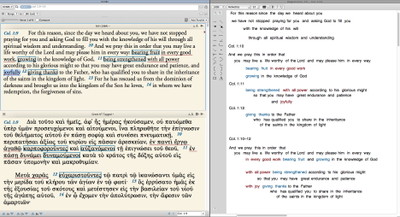Yesterday I told you about the Sunday School class I’m teaching on Bible Study methods using the book of Colossians. I told you about the I See! So What? Hmm… method, and showed how I used a User Notes file as a convenient way to record the class’s observations, applications, and questions about Colossians 1:3-8.
The next week we went over Paul’s prayer for the Colossians in 1:9-14, and this gave me a great opportunity to talk about one particular kind of observation they should make when studying a passage. You see, when we read these verses, we typically think that Paul is praying for a long series of things: that the Colossians would be “filled with the knowledge of [God’s] will,” that they would “live a life worthy of the Lord,” “bear fruit in every good work,” “be strengthened with all power,” and “joyfully give thanks to the Father.” However, if we look carefully at the grammar and syntax of this passage, we observe that he really only prays for one thing.
Of all the translations I looked at in preparation for the class, the 1984 NIV brought out the structure of the passage most clearly. It reads, “we have not stopped praying for you and asking God to fill you with the knowledge of his will through all spiritual wisdom and understanding.” Note the period. That’s the end of Paul’s prayer. He then goes on to say, “we pray this in order that you may live a life worthy of the Lord and may please him in every way:”. At this point he is merely explaining his reasons for praying that the Colossians would be filled with the knowledge of God’s will. His assumption is that if they are so filled, they will live in a way that pleases the Lord.
Now note the colon the NIV places after Paul’s reason for his prayer. It is followed by a series of four participles, all of which explain what it looks like to live a life that pleases the Lord. Other translations often break this section up into two or more separate sentences, changing one of the participles to an independent verb to avoid a run-on sentence. Yet in so doing they obscure the relationship between this series of participles and what comes before.
Things get even more interesting in the Greek. When I looked at that, I found that there are indeed four Greek participles, just as the 1984 NIV translates. Yet these participles are organized into three clauses, each of which begins with a prepositional phrase. This latter structure even the 1984 NIV obscures, simply because it would be awkward to translate literally into English. A more wooden translation would read, “in every good work bearing fruit and growing…, with all power being strengthened…, and with joy giving thanks…”.
To help my class see these subtle differences in structure, I used the diagram window to do a simple block diagram of the passage as translated by the 1984 NIV, as well as how it might be woodenly translated from the Greek. I also used highlight styles and colors in the diagram to help show the key elements (that is, the participles and prepositional phrases).
This simple combination of highlight styles and a diagram make it easy to see the structure of this passage. The 1984 NIV makes the four Greek participles transparent, and my modification of the NIV brings out the structure of the passage into three clauses beginning with prepositional phrases. After showing this to my class, I pointed out that the phrase “growing in the knowledge of God” is grouped with the prepositional phrase “in every good work.” I then asked them to wrestle with the relationship between those two ideas.
My goal here was to show my class how observing grammatical and syntactical details can help them understand a passage, and that this is something they can easily do using a good translation. On the other hand, this passage also gave me a chance to show the benefits of being able to study the original languages. Translations will always obscure the grammar and syntax of the original, which is one reason pastors and scholars study the languages.
I’m obviously trying to walk a fine line with this last point. I don’t expect my Sunday School class to go out and learn Greek and Hebrew, and I want them to feel that they can clearly understand the meaning of a passage using a good translation. On the other hand, I want them to see that those who study the languages are not engaging in useless sophistry, but are simply going a little deeper in their study of the Bible.
Whether or not they fully grasped those points remains to be seen, but I felt that the combination of highlighting and diagramming gave me an effective visual aid in trying to make those points as clearly as I could.


